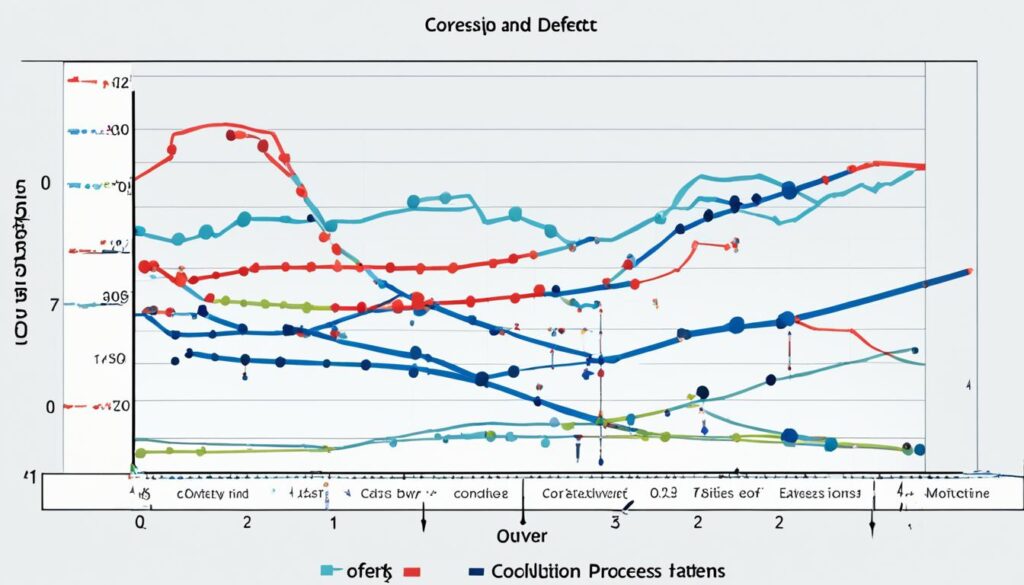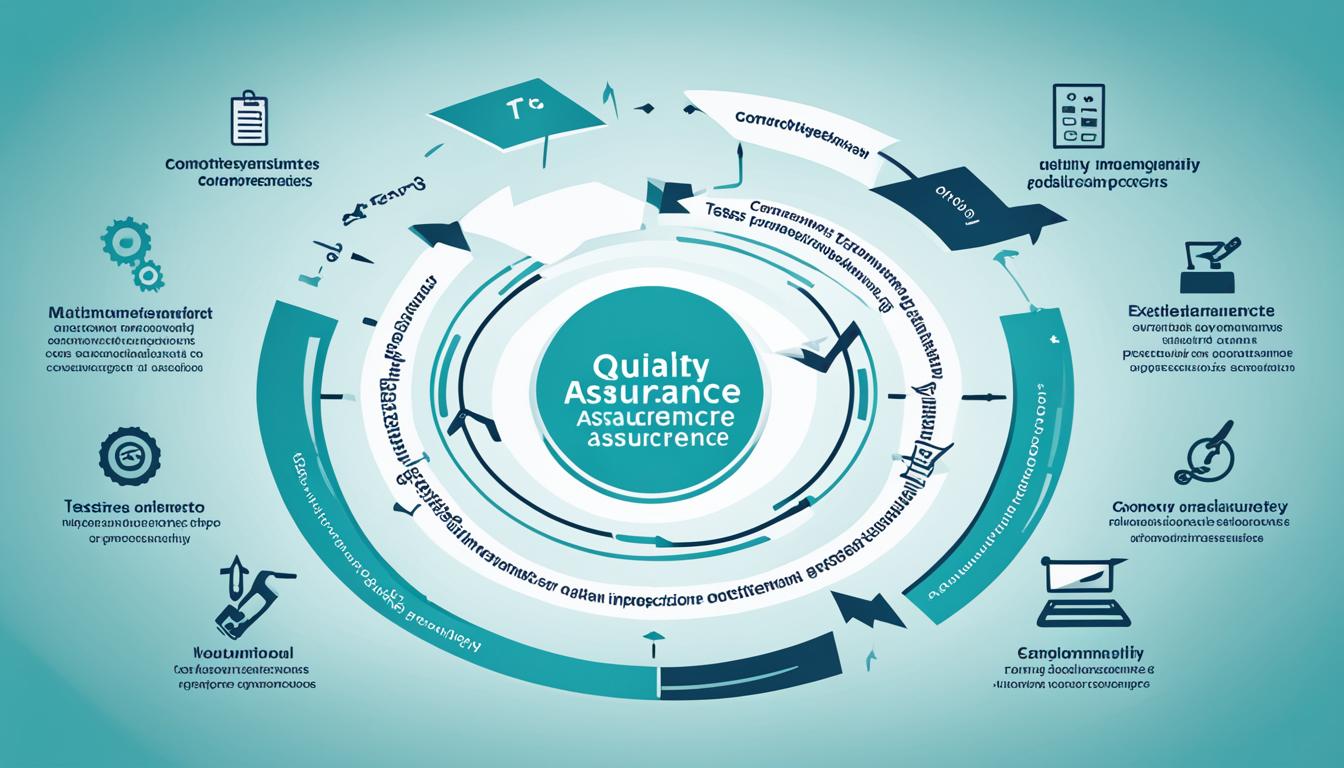Welcome to our detailed overview of quality assurance, emphasizing its crucial role in maintaining rigorous quality control standards. As professionals in our field, we understand the significance of delivering top-notch products and services to our customers. That is why we give priority to quality assurance, dedicated to offering you valuable advice and the most efficient tactics for upholding the highest quality benchmarks.
Quality assurance is the process of systematically monitoring and evaluating the various aspects of a product or service to ensure it meets predefined quality standards. It involves a combination of planning, implementation, and continuous improvement to ensure consistent excellence.
In this guide, we will explore the fundamentals of quality assurance, its impact on customer satisfaction, and its vital role in upholding quality standards. We will also delve into the various methods, processes, and systems that organizations can implement to ensure product or service quality. Additionally, we will discuss the difference between quality assurance and quality control, and how both contribute to quality improvement.
Our aim is to equip you with the knowledge and tools necessary to implement effective quality assurance practices and create a robust quality management system. By prioritizing quality assurance, you can enhance customer satisfaction, build trust, and establish a reputation for excellence in your industry.
Key Takeaways:
- Quality assurance plays a crucial role in maintaining excellence in quality control
- It involves monitoring and evaluating products or services to ensure predefined quality standards are met
- Implementing effective quality assurance practices can enhance customer satisfaction
- Quality assurance forms the foundation for a robust quality management system
- By prioritizing quality assurance, organizations can establish a reputation for excellence
What is Quality Assurance and Its Importance?
In today’s fast-paced and competitive business environment, ensuring the excellence of products and services is paramount for organizations looking to gain a competitive edge. This is where quality assurance comes into play. Quality assurance refers to the systematic process of ensuring that products, processes, and services consistently meet or exceed predetermined quality standards.
Quality assurance is not to be confused with quality control. While quality control focuses on identifying and fixing defects in the final product or service, quality assurance is a proactive approach that aims to prevent issues from arising in the first place. It is a preventive measure that emphasizes the importance of implementing robust quality management systems.
So, why is quality assurance so important in product or service development? The answer lies in its ability to enhance customer satisfaction, increase efficiency, and drive continuous improvement. By adhering to strict quality assurance processes, organizations can ensure that their products or services consistently meet customer requirements and expectations.
In software development, quality assurance plays a critical role in ensuring the reliability, functionality, and security of the software. It involves rigorous testing, code reviews, and adherence to coding standards, ensuring that the final product is of high quality and free from bugs or vulnerabilities.
A robust quality management system is the backbone of effective quality assurance. It encompasses a set of interconnected processes, procedures, and policies aimed at achieving and maintaining consistent quality throughout the organization. A well-implemented quality management system not only ensures compliance with quality standards but also fosters a culture of continuous improvement and customer-centricity.
By prioritizing quality assurance and implementing a comprehensive quality management system, organizations can enhance their reputation, build customer trust, and gain a competitive advantage in the market.
Quality Assurance Methods and Processes
In order to ensure the highest level of product or service quality, organizations employ various quality assurance methods and processes. These strategies are designed to identify and rectify any potential issues or defects, guaranteeing that the final deliverable meets the required standards and customer expectations. Let’s explore some of the most effective quality assurance testing strategies and processes that organizations can implement:
Effective Quality Assurance Testing Strategies
Quality assurance testing is a crucial component of the overall quality management process. By conducting thorough and systematic testing, organizations can identify and address any defects or inconsistencies before the product or service is released to the market. Some effective quality assurance testing strategies include:
- Functional Testing: This type of testing validates that the product or service functions as intended and meets the specified requirements.
- Performance Testing: Performance testing assesses the product or service’s ability to perform under different conditions and loads, ensuring it meets performance expectations.
- Security Testing: Security testing identifies any vulnerabilities or weaknesses in the product or service’s security measures, protecting sensitive data from potential threats.
- User Acceptance Testing: User acceptance testing involves testing the product or service with end-users to ensure it meets their needs and expectations.
- Regression Testing: Regression testing verifies that recent changes or updates to the product or service have not introduced any new defects or issues.
Implementing Statistical Process Control in Quality Assurance
Statistical process control (SPC) is a valuable technique used in quality assurance to monitor and control production processes. By using statistical methods and tools, organizations can ensure that their processes are stable, predictable, and capable of consistently producing high-quality outputs. SPC involves:
- Collecting and analyzing data to identify trends and patterns in process performance.
- Using statistical techniques, such as control charts and process capability analysis, to monitor and control process variability.
- Determining the appropriate control limits to indicate when a process is in or out of control.
- Implementing corrective actions when process performance deviates from the desired standards.

Quality Assurance Programs and Systems
Organizations can establish quality assurance programs and systems to ensure consistent and effective quality management. These programs and systems provide a framework for controlling quality across various functions and processes. They typically include:
- Standard operating procedures (SOPs) and work instructions that outline quality-related processes and tasks.
- Document control systems to manage and maintain up-to-date versions of quality-related documents.
- Training and education programs to equip employees with the necessary knowledge and skills to adhere to quality standards.
- Internal audit processes to assess adherence to quality requirements and identify areas for improvement.
- Corrective and preventive action (CAPA) processes to address non-conformances and prevent their recurrence.
Quality Assurance in the Context of Total Quality Management
Quality assurance plays a vital role in the broader context of total quality management (TQM). TQM is a comprehensive approach to quality management that involves the active participation of all employees and focuses on continuous improvement. Quality assurance ensures that the principles and practices of TQM are implemented effectively, enabling organizations to achieve and exceed customer expectations. By integrating quality assurance into the TQM framework, organizations can:
- Identify and eliminate root causes of quality issues.
- Implement systematic and data-driven improvement initiatives.
- Establish clear quality objectives and performance metrics.
- Promote a culture of quality and continuous improvement throughout the organization.
ISO 9000 and Its Significance in Quality Assurance
ISO 9000 is an internationally recognized standard for quality management systems. Adhering to ISO 9000 standards demonstrates an organization’s commitment to delivering consistent, high-quality products or services. ISO 9000 provides a framework for implementing effective quality assurance practices and emphasizes the importance of:
- Establishing a customer-focused approach to quality management.
- Implementing robust processes and systems to control quality.
- Continually monitoring and improving quality performance.
- Engaging and empowering employees to contribute to quality objectives.
By aligning their quality assurance practices with ISO 9000, organizations can enhance customer satisfaction, improve operational efficiency, and drive continuous improvement in quality management.
Complete Table
| Quality Assurance Method/Process | Description |
|---|---|
| Effective Quality Assurance Testing Strategies | Thorough and systematic testing approaches to identify and address defects or inconsistencies. |
| Implementing Statistical Process Control | Using statistical methods/tools to monitor and control production processes. |
| Quality Assurance Programs and Systems | Establishing frameworks for controlling quality across functions and processes. |
| Quality Assurance in the Context of Total Quality Management | Integration of quality assurance into the broader TQM framework for continuous improvement. |
| ISO 9000 and Its Significance | Adherence to internationally recognized standards for quality management systems. |
Quality Assurance vs Quality Control: Understanding the Difference
In the world of quality management, two terms often come up: quality assurance and quality control. While they may sound similar, they have distinct roles and objectives. Let’s delve into these concepts and gain a clear understanding of their differences.
Defining the Differences Between Quality Assurance and Quality Control
Quality assurance (QA) is a proactive process focused on preventing defects and errors from occurring in the first place. It involves creating and implementing systems, procedures, and standards to ensure that the desired level of quality is consistently achieved. QA activities include quality planning, process reviews, and continuous improvement efforts to enhance overall quality performance.
On the other hand, quality control (QC) is a reactive process focused on identifying and correcting deviations from established quality standards. It involves inspecting, testing, and evaluating products or services to detect defects and ensure that they meet the predetermined quality criteria. QC activities include product inspections, sample testing, and statistical analysis to maintain quality compliance.
Quality Improvement Through Effective Quality Assurance and Quality Control
Both quality assurance and quality control play crucial roles in improving the overall quality of products or services. By implementing robust quality assurance practices, organizations can identify potential areas of improvement, establish effective processes, and minimize the occurrence of defects. Quality control, on the other hand, ensures that the established quality standards are upheld by conducting thorough inspections and tests, allowing for prompt identification and rectification of any deviations.
Ensuring Product or Service Quality through Quality Assurance and Quality Control
Quality assurance and quality control go hand in hand to ensure the delivery of high-quality products or services to customers. While quality assurance focuses on prevention and process improvement, quality control ensures that the final output meets the specified quality requirements. By implementing comprehensive quality management systems that encompass both QA and QC practices, organizations can provide consistent, reliable, and satisfying products or services to their customers.
The Role of Quality Audits in Quality Assurance and Quality Control
One of the essential components of quality assurance and quality control is conducting regular quality audits. Quality audits are systematic examinations of processes, procedures, and systems to assess their compliance with established quality standards. By periodically reviewing and evaluating various aspects of the organization’s quality management system, quality audits help identify areas for improvement, ensure adherence to quality guidelines, and mitigate the risk of non-compliance.
Implementing Quality Planning to Ensure Excellence in Quality Assurance and Quality Control
Quality planning is an integral part of both quality assurance and quality control. It involves the systematic identification of quality objectives, the development of quality plans, and the establishment of processes to achieve desired quality outcomes. By defining clear quality goals, outlining quality-related activities, and allocating appropriate resources, organizations can effectively execute quality assurance and quality control practices, leading to improved product or service quality, customer satisfaction, and overall organizational success.

| Quality Assurance | Quality Control |
|---|---|
| Proactive process | Reactive process |
| Focuses on prevention | Focuses on detection and correction |
| Ensures consistent quality | Verifies compliance to quality standards |
| Includes process reviews and improvement | Includes product inspections and testing |
| Minimizes defects and errors | Identifies and rectifies deviations |
The Role of Quality Management in Quality Assurance
In order to ensure the quality of our products or services, quality management plays a crucial role. Quality management encompasses a set of processes and practices that are focused on maintaining and improving the quality of our offerings. By implementing effective quality management systems, we are able to uphold high standards and meet the expectations of our customers.

Quality Management Systems and Their Impact on Quality Assurance
Quality management systems form the foundation of an organization’s quality assurance efforts. These systems consist of various interrelated processes and procedures that are designed to systematically monitor, control, and improve the quality of products or services throughout their lifecycle. By implementing a robust quality management system, we can ensure consistency, reliability, and continual improvement in our offerings.
Understanding the Concept of Quality and Its Importance in Quality Management
Quality is more than just meeting predetermined standards or specifications. It encompasses the entire customer experience and reflects the extent to which our products or services satisfy customer needs and expectations. Quality management recognizes the significance of meeting or exceeding customer requirements and seeks to continuously improve the processes and systems that contribute to product or service quality.
Effectively Meeting Quality Requirements through Quality Management
One of the primary objectives of quality management is to ensure that our products or services meet the specified quality requirements. This involves setting clear quality objectives, defining quality criteria, and implementing quality control measures to ensure the desired level of quality is achieved. By closely monitoring and measuring key quality indicators, we can identify areas for improvement and take proactive steps to enhance product or service quality.
The Aspects of Quality Management: Ensuring Excellence in Every Aspect
Quality management encompasses various aspects that are integral to delivering excellence in product or service quality. These aspects include:
- Leadership commitment and involvement in quality initiatives
- Employee engagement and empowerment to contribute to quality improvement
- Effective communication and collaboration to align quality objectives
- Data-driven decision-making based on accurate and reliable information
- Continuous learning and knowledge sharing to foster a culture of quality improvement
Ensuring Product or Service Quality through Quality Assurance
In today’s competitive market, organizations must prioritize the quality of their products or services to stay ahead. This is where quality assurance plays a crucial role. By implementing robust quality assurance processes in product development, companies can ensure that their offerings meet the highest standards.
Quality assurance also extends beyond product development and encompasses service quality management. Organizations can effectively implement quality assurance measures to maintain consistent service quality, enhancing customer satisfaction. Through thorough testing, monitoring, and evaluation, potential quality issues can be identified and resolved, ensuring that customers receive exceptional service.
Dealing with quality issues is another area where effective quality assurance initiatives come into play. By conducting regular audits and inspections, organizations can proactively identify and address any quality issues that may arise. This enables them to rectify the problems swiftly and prevent their recurrence, ultimately safeguarding product or service quality.
Ultimately, the goal of quality assurance is to ensure excellence in product or service quality. By implementing comprehensive quality assurance measures, organizations can establish a strong foundation for consistently delivering exceptional offerings to their customers. This dedication to quality leads to higher customer satisfaction, forging long-lasting relationships and fostering brand loyalty.
Quality Assurance FAQ
Q: What is the role of a quality assurance specialist in the software development process?
A: A quality assurance specialist plays a crucial role in the software development process. They not only control the quality of the product, but also ensure that all stages of the development meet the defined standards. Quality assurance helps in achieving higher quality of products and services.
Q: What is the difference between quality control and quality assurance?
A: Quality assurance and quality control are both parts of quality management focused on product quality. However, they serve different functions. Quality control focuses on detecting and correcting defects in the finished product, while quality assurance focuses on the process used to create the product. In other words, QA is a proactive process, while QC is a reactive one.
Q: How does software quality assurance ensure quality in the development process?
A: Software quality assurance is a part of quality management focused on providing confidence that quality requirements will be fulfilled. The QA process involves systematic activities and tasks to ensure quality in the development process, including regular reviews, audits and testing, hence it helps to maintain the quality of the product.
Q: What are the best practices for quality assurance in software development?
A: The best practices for quality assurance in software development include establishing a quality assurance system with clear strategies and procedures, conducting regular reviews and audits, continuous testing, close engagement with the development team, and focusing on continuous improvement.
Q: What’s the importance of quality in software development?
A: The importance of quality in software development cannot be overstated – it has a significant impact on user satisfaction, product performance, and the overall success of the product. Quality software meets the needs of the user, is reliable, and is free from defects. A strong quality assurance system can ensure these standards are met.
Q: What are the types of quality assurance in software development?
A: There are several types of quality assurance in software development, including process, product, and project quality assurance. Each focuses on different aspects of quality management: the methods used to create the product, the product itself, and the entire development cycle respectively.
### ###
Q: What is the role of quality assurance engineers in ensuring excellent quality control?
A: Quality assurance engineers are integral to ensuring excellent quality control. They design and execute tests, report issues to the development team, help troubleshoot issues, and ensure that all aspects of the software meet the quality standards set. Their work is a vital part of the quality assurance function, contributing significantly to the overall quality of the product.
Q: What is the QA process in software development?
A: The QA process in software development involves several steps, including planning and control, software development lifecycle testing, software development lifecycle observation, and conducting a final review. These steps ensure that the quality management is focused on meeting the quality requirements of the product.
Q: How does quality assurance system monitor and manage the quality of a product?
A: A quality assurance system monitors and manages product quality by implementing standard procedures and processes throughout the development lifecycle. It ensures all processes are carried out in accordance with set guidelines, enables early detection and prevention of potential errors or issues, and promotes a culture of continuous improvement in quality standards.
Q: Why is quality assurance often considered a critical part of software development?
A: Quality assurance is often considered a critical part of software development because it directly impacts the overall quality of the product. Through systematic activities and thorough testing, QA ensures that the software meets the defined quality standards and the expectations of the end user, leading to better customer satisfaction and trust in the product.









